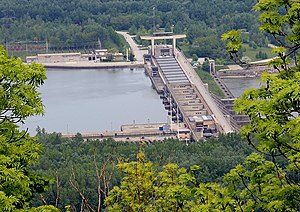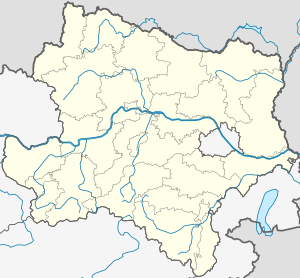Greifenstein power plant
| Greifenstein power plant | ||
|---|---|---|
| Greifenstein power plant (seen from the south) | ||
| location | ||
|
|
||
| Coordinates | 48 ° 21 '15 " N , 16 ° 14' 30" E | |
| country |
|
|
| place | Greifenstein | |
| Waters | Danube | |
| Kilometers of water | km 1949.18 | |
| Height upstream | 177 m above sea level A. | |
| power plant | ||
| owner | VERBUND Hydro Power AG | |
| operator | VERBUND Hydro Power AG | |
| construction time | 1981-1985 | |
| technology | ||
| Bottleneck performance | 293 megawatts | |
| Average height of fall |
12.6 m | |
| Expansion flow | 3,150 m³ / s | |
| Standard work capacity | 1,717 million kWh / year | |
| Turbines | 9 Kaplan bulb turbines | |
| Generators | 9 synchronous generators | |
| Others | ||
| was standing | August 2007 | |
The Greifenstein power plant is a run-of- river power plant in the Austrian Danube in the state of Lower Austria , 20 km northwest of Vienna . It is located on the south-eastern edge of the Tullnerfeld, north of Greifenstein and south of Stockerau and Spillern .
history
In 1981 Österreichische Donaukraftwerke AG began building the most powerful hydroelectric power plant of all Austrian Danube power plants after the Altenwörth power plant . The dam was built north of the original river bed in dry and low-rise construction. 1985 was electricity plant put into operation since 1999 is barrage of VERBUND Hydro Power AG operated.
technical description
Dam
The 455 m long dam dams the Danube at river kilometer 1,949.18 over a length of around 31 km up to a height of 16.6 m. The content of the storage space is approx. 87 million m³, the storage target is at an altitude of 177 m above sea level. A. At the right end of the dam (southern bank) are the two locks , each with a usable length of 230 m and a usable width of 24 m. The dam can be crossed on foot or by bike.
The weir consists of six weir fields with a width of 24 m each and is located north of the two locks.
Machine house
The machine house is located next to the weir system at the left end of the dam (northern bank). Nine sets of machines supply electrical energy to the public grid . Each machine set consists of a Kaplan bulb turbine with a directly coupled synchronous machine . Each of the running wheels has a diameter of 6.5 m, a horizontal shaft and lies at 154.25 m above sea level.
The rated output of turbines 1 to 3 is 34,700 kW each , turbines 4 to 6 are 34,500 kW each and turbines 7 to 9 are 35,000 kW each. The displacement per turbine is 350 m³ / s, the nominal speed 93.75 min −1 .
The nine synchronous generators , designed as salient pole machines with a horizontal shaft, have an apparent power of 38 MVA each at a nominal voltage (generator voltage) of 8 kV . The generator voltage is, about three in the nacelle integrated generator transformers highly transformed with a rated power of 114 MVA to 220 kV, wherein always three generators are combined on a machine transformer. An open-air switchgear located on the north bank is used to conduct the electrical energy to the Bisamberg substation via a double three-phase system, designed as an overhead line .
Overall, the power plant has a bottleneck capacity of 293 MW. With an expanded flow rate of 3,150 m³ / s, the standard energy capacity is 1,717.3 GWh per year .
ecology
Pouring channel
As a result of the Viennese Danube regulation at the end of the 19th century, the Danube dug deeper and deeper into the river bed. As a result, the groundwater level on the left side of the Danube sank, which threatened the Stockerauer Au with drying out. In the course of the construction of the power plant, an irrigation system was built, the so-called pouring channel , which ensures natural fluctuations in the water level.
Fish pass
A fish pass runs north of the Danube in the form of a near-natural bypass stream. Over a length of 4 km, the stream overcomes the height difference of 12 meters between underwater and upstream. The construction took place from April 2016 to January 2018.
See also
literature
- Gerhard A. Stadler, Manfred Wehdorn , Monika Keplinger, Valentin E. Wille: Architektur im Verbund (= series of research in Verbund 100). Springer Verlag, Vienna et al. 2007, ISBN 978-3-211-75795-6 .
Web links
- Website for the Greifenstein power plant
- Floodplain landscape and power plant construction - eco-technology using the example of the Greifenstein barrage
- Greifenstein power plant during the flood in June 2013


